Decision-Making in End-of-Life Care: A Case Study Analysis
VerifiedAdded on 2022/09/02
|11
|2703
|12
Case Study
AI Summary
This case study centers on a 55-year-old woman, Jean, diagnosed with stage IV pancreatic cancer, presenting a complex scenario involving ethical, legal, and professional challenges in end-of-life care. The case study highlights Jean's admission to the hospital with severe symptoms including abdominal pain, fever, and compromised vital signs, along with her desire to return home and her refusal of treatment. The essay identifies key medical, social, legal, and ethical issues, including the ethical dilemmas between beneficence, autonomy, and non-maleficence. It discusses consent, advance directives, and relevant legislation such as the Voluntary Assisted Dying Act 2017. The analysis delves into ethical principles, professional standards, and the importance of informed consent and accurate documentation. The solution emphasizes the need to balance the patient's wishes with professional responsibilities, advocating for pain management, comfort care, and adherence to advance directives, while resolving the ethical dilemmas by adhering to the ethical and legal principles. The conclusion stresses the importance of providing comfort, respecting patient autonomy, and offering hospice care to address the patient's emotional and physical needs.
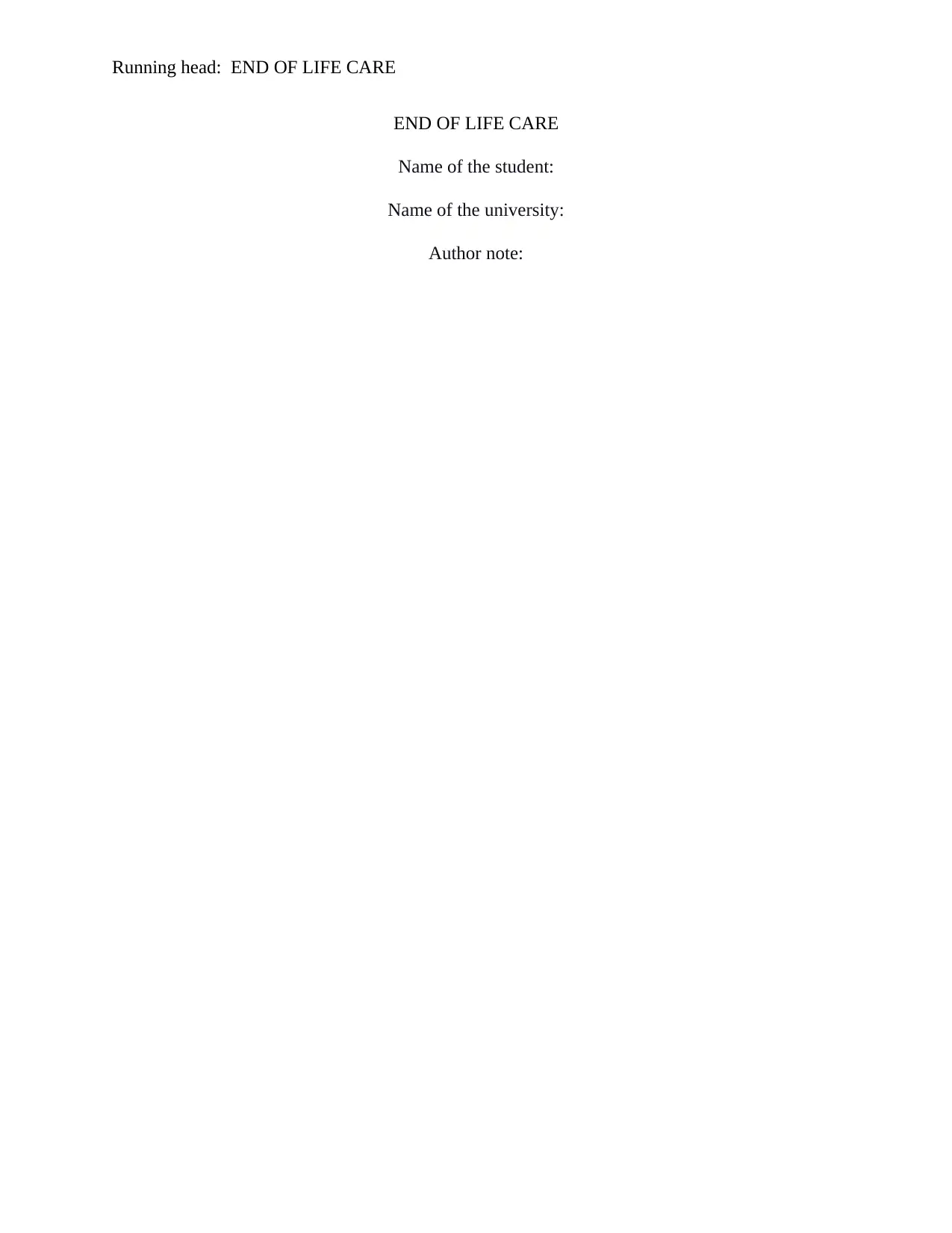
Running head: END OF LIFE CARE
END OF LIFE CARE
Name of the student:
Name of the university:
Author note:
END OF LIFE CARE
Name of the student:
Name of the university:
Author note:
Paraphrase This Document
Need a fresh take? Get an instant paraphrase of this document with our AI Paraphraser
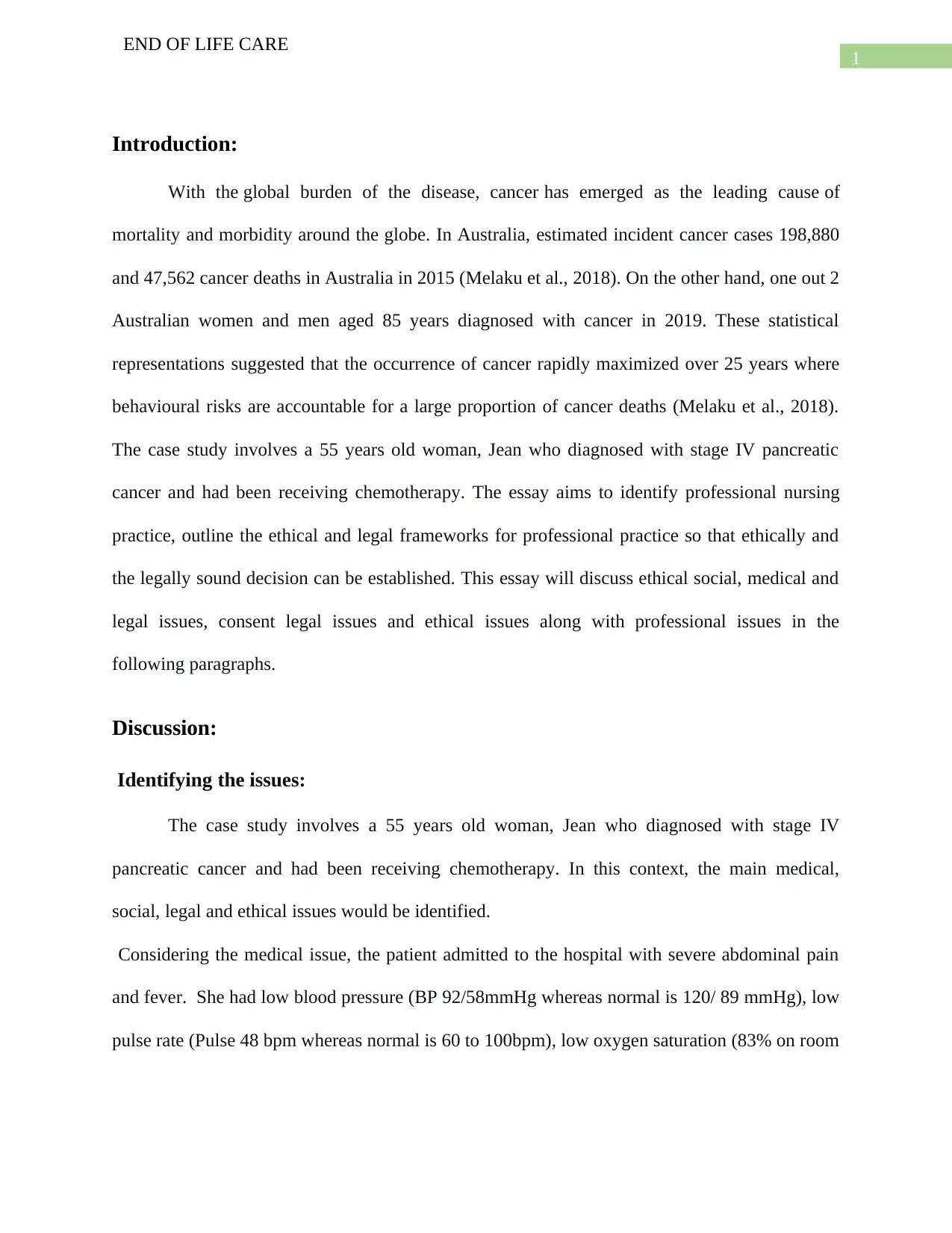
1
END OF LIFE CARE
Introduction:
With the global burden of the disease, cancer has emerged as the leading cause of
mortality and morbidity around the globe. In Australia, estimated incident cancer cases 198,880
and 47,562 cancer deaths in Australia in 2015 (Melaku et al., 2018). On the other hand, one out 2
Australian women and men aged 85 years diagnosed with cancer in 2019. These statistical
representations suggested that the occurrence of cancer rapidly maximized over 25 years where
behavioural risks are accountable for a large proportion of cancer deaths (Melaku et al., 2018).
The case study involves a 55 years old woman, Jean who diagnosed with stage IV pancreatic
cancer and had been receiving chemotherapy. The essay aims to identify professional nursing
practice, outline the ethical and legal frameworks for professional practice so that ethically and
the legally sound decision can be established. This essay will discuss ethical social, medical and
legal issues, consent legal issues and ethical issues along with professional issues in the
following paragraphs.
Discussion:
Identifying the issues:
The case study involves a 55 years old woman, Jean who diagnosed with stage IV
pancreatic cancer and had been receiving chemotherapy. In this context, the main medical,
social, legal and ethical issues would be identified.
Considering the medical issue, the patient admitted to the hospital with severe abdominal pain
and fever. She had low blood pressure (BP 92/58mmHg whereas normal is 120/ 89 mmHg), low
pulse rate (Pulse 48 bpm whereas normal is 60 to 100bpm), low oxygen saturation (83% on room
END OF LIFE CARE
Introduction:
With the global burden of the disease, cancer has emerged as the leading cause of
mortality and morbidity around the globe. In Australia, estimated incident cancer cases 198,880
and 47,562 cancer deaths in Australia in 2015 (Melaku et al., 2018). On the other hand, one out 2
Australian women and men aged 85 years diagnosed with cancer in 2019. These statistical
representations suggested that the occurrence of cancer rapidly maximized over 25 years where
behavioural risks are accountable for a large proportion of cancer deaths (Melaku et al., 2018).
The case study involves a 55 years old woman, Jean who diagnosed with stage IV pancreatic
cancer and had been receiving chemotherapy. The essay aims to identify professional nursing
practice, outline the ethical and legal frameworks for professional practice so that ethically and
the legally sound decision can be established. This essay will discuss ethical social, medical and
legal issues, consent legal issues and ethical issues along with professional issues in the
following paragraphs.
Discussion:
Identifying the issues:
The case study involves a 55 years old woman, Jean who diagnosed with stage IV
pancreatic cancer and had been receiving chemotherapy. In this context, the main medical,
social, legal and ethical issues would be identified.
Considering the medical issue, the patient admitted to the hospital with severe abdominal pain
and fever. She had low blood pressure (BP 92/58mmHg whereas normal is 120/ 89 mmHg), low
pulse rate (Pulse 48 bpm whereas normal is 60 to 100bpm), low oxygen saturation (83% on room
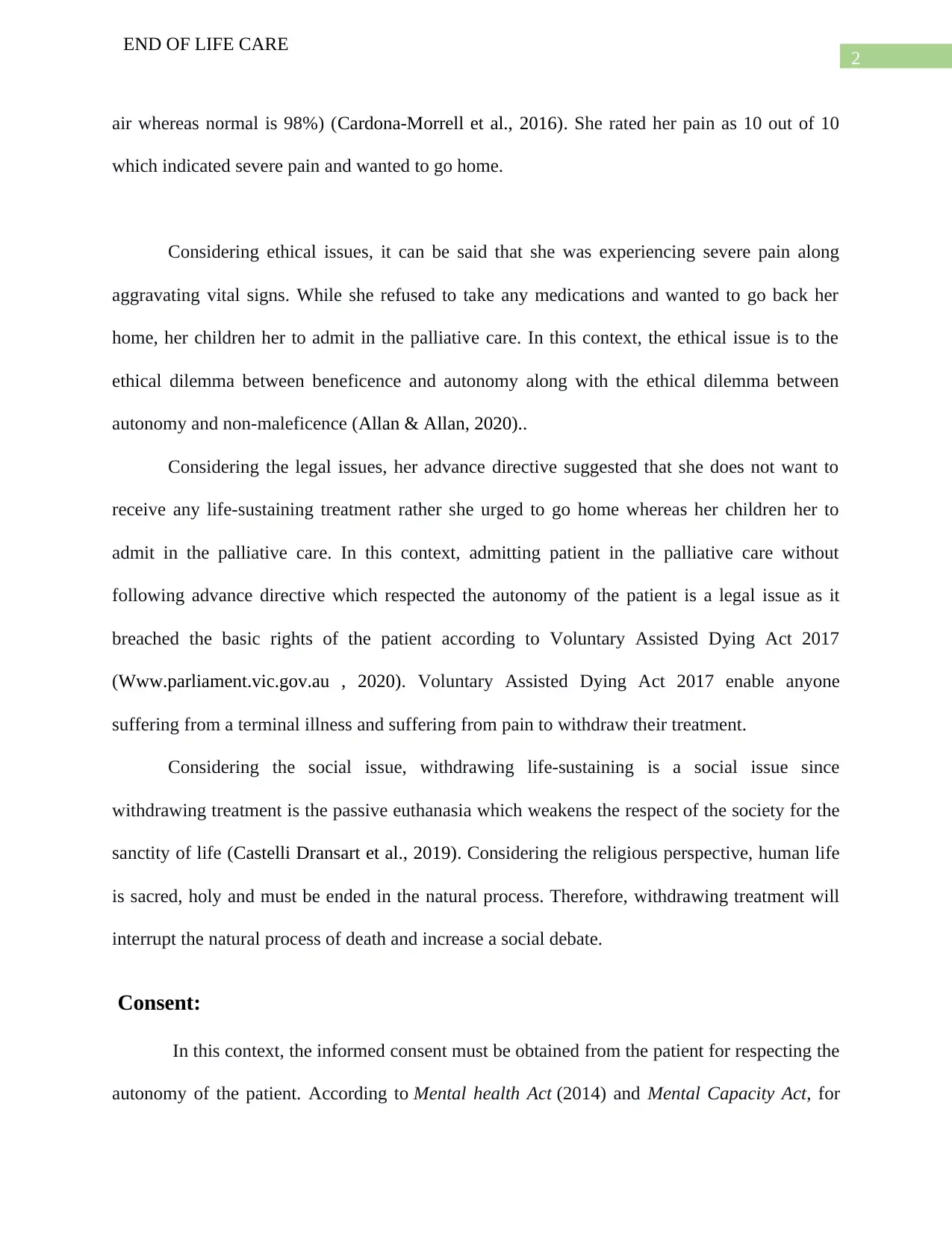
2
END OF LIFE CARE
air whereas normal is 98%) (Cardona-Morrell et al., 2016). She rated her pain as 10 out of 10
which indicated severe pain and wanted to go home.
Considering ethical issues, it can be said that she was experiencing severe pain along
aggravating vital signs. While she refused to take any medications and wanted to go back her
home, her children her to admit in the palliative care. In this context, the ethical issue is to the
ethical dilemma between beneficence and autonomy along with the ethical dilemma between
autonomy and non-maleficence (Allan & Allan, 2020)..
Considering the legal issues, her advance directive suggested that she does not want to
receive any life-sustaining treatment rather she urged to go home whereas her children her to
admit in the palliative care. In this context, admitting patient in the palliative care without
following advance directive which respected the autonomy of the patient is a legal issue as it
breached the basic rights of the patient according to Voluntary Assisted Dying Act 2017
(Www.parliament.vic.gov.au , 2020). Voluntary Assisted Dying Act 2017 enable anyone
suffering from a terminal illness and suffering from pain to withdraw their treatment.
Considering the social issue, withdrawing life-sustaining is a social issue since
withdrawing treatment is the passive euthanasia which weakens the respect of the society for the
sanctity of life (Castelli Dransart et al., 2019). Considering the religious perspective, human life
is sacred, holy and must be ended in the natural process. Therefore, withdrawing treatment will
interrupt the natural process of death and increase a social debate.
Consent:
In this context, the informed consent must be obtained from the patient for respecting the
autonomy of the patient. According to Mental health Act (2014) and Mental Capacity Act, for
END OF LIFE CARE
air whereas normal is 98%) (Cardona-Morrell et al., 2016). She rated her pain as 10 out of 10
which indicated severe pain and wanted to go home.
Considering ethical issues, it can be said that she was experiencing severe pain along
aggravating vital signs. While she refused to take any medications and wanted to go back her
home, her children her to admit in the palliative care. In this context, the ethical issue is to the
ethical dilemma between beneficence and autonomy along with the ethical dilemma between
autonomy and non-maleficence (Allan & Allan, 2020)..
Considering the legal issues, her advance directive suggested that she does not want to
receive any life-sustaining treatment rather she urged to go home whereas her children her to
admit in the palliative care. In this context, admitting patient in the palliative care without
following advance directive which respected the autonomy of the patient is a legal issue as it
breached the basic rights of the patient according to Voluntary Assisted Dying Act 2017
(Www.parliament.vic.gov.au , 2020). Voluntary Assisted Dying Act 2017 enable anyone
suffering from a terminal illness and suffering from pain to withdraw their treatment.
Considering the social issue, withdrawing life-sustaining is a social issue since
withdrawing treatment is the passive euthanasia which weakens the respect of the society for the
sanctity of life (Castelli Dransart et al., 2019). Considering the religious perspective, human life
is sacred, holy and must be ended in the natural process. Therefore, withdrawing treatment will
interrupt the natural process of death and increase a social debate.
Consent:
In this context, the informed consent must be obtained from the patient for respecting the
autonomy of the patient. According to Mental health Act (2014) and Mental Capacity Act, for
⊘ This is a preview!⊘
Do you want full access?
Subscribe today to unlock all pages.

Trusted by 1+ million students worldwide
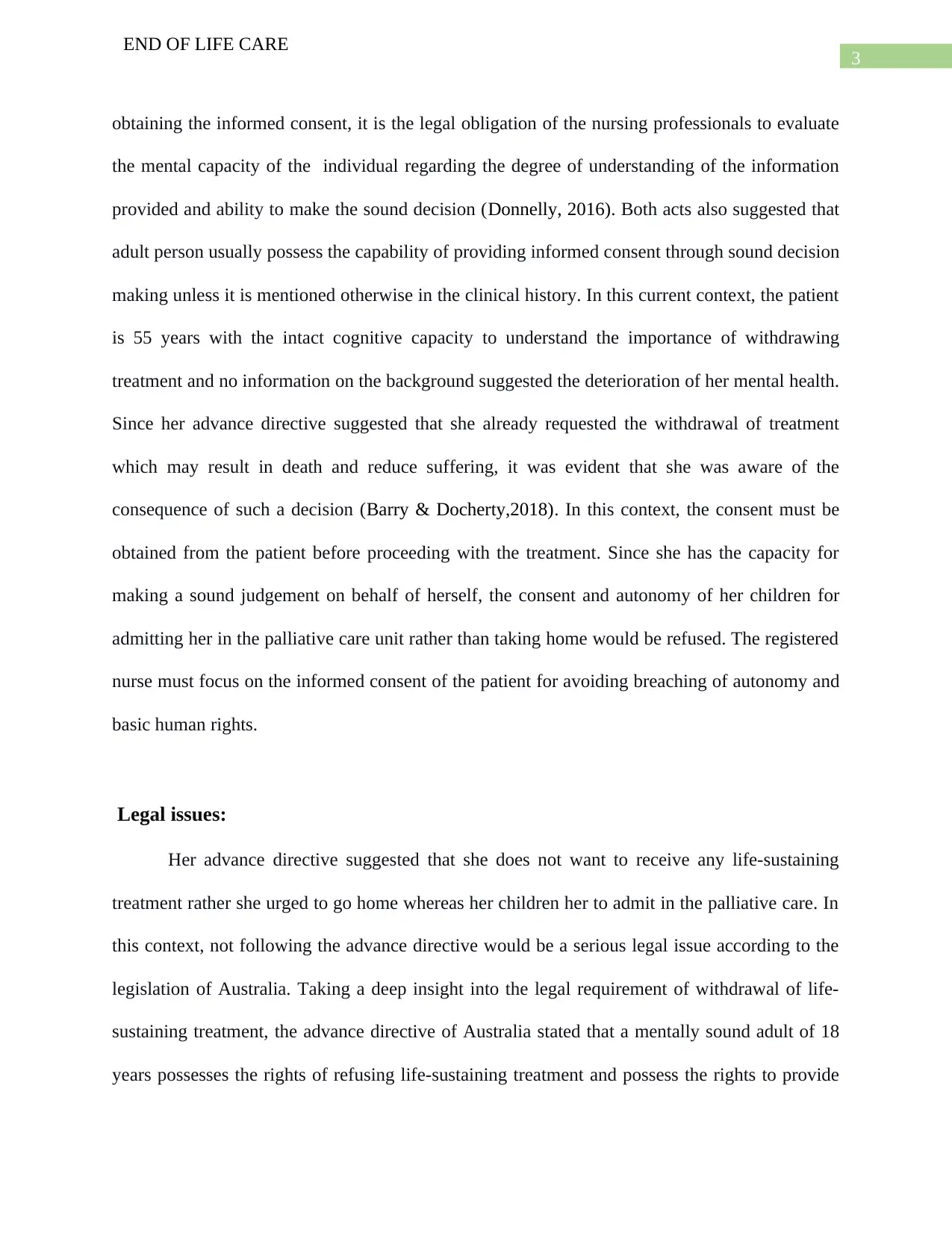
3
END OF LIFE CARE
obtaining the informed consent, it is the legal obligation of the nursing professionals to evaluate
the mental capacity of the individual regarding the degree of understanding of the information
provided and ability to make the sound decision (Donnelly, 2016). Both acts also suggested that
adult person usually possess the capability of providing informed consent through sound decision
making unless it is mentioned otherwise in the clinical history. In this current context, the patient
is 55 years with the intact cognitive capacity to understand the importance of withdrawing
treatment and no information on the background suggested the deterioration of her mental health.
Since her advance directive suggested that she already requested the withdrawal of treatment
which may result in death and reduce suffering, it was evident that she was aware of the
consequence of such a decision (Barry & Docherty,2018). In this context, the consent must be
obtained from the patient before proceeding with the treatment. Since she has the capacity for
making a sound judgement on behalf of herself, the consent and autonomy of her children for
admitting her in the palliative care unit rather than taking home would be refused. The registered
nurse must focus on the informed consent of the patient for avoiding breaching of autonomy and
basic human rights.
Legal issues:
Her advance directive suggested that she does not want to receive any life-sustaining
treatment rather she urged to go home whereas her children her to admit in the palliative care. In
this context, not following the advance directive would be a serious legal issue according to the
legislation of Australia. Taking a deep insight into the legal requirement of withdrawal of life-
sustaining treatment, the advance directive of Australia stated that a mentally sound adult of 18
years possesses the rights of refusing life-sustaining treatment and possess the rights to provide
END OF LIFE CARE
obtaining the informed consent, it is the legal obligation of the nursing professionals to evaluate
the mental capacity of the individual regarding the degree of understanding of the information
provided and ability to make the sound decision (Donnelly, 2016). Both acts also suggested that
adult person usually possess the capability of providing informed consent through sound decision
making unless it is mentioned otherwise in the clinical history. In this current context, the patient
is 55 years with the intact cognitive capacity to understand the importance of withdrawing
treatment and no information on the background suggested the deterioration of her mental health.
Since her advance directive suggested that she already requested the withdrawal of treatment
which may result in death and reduce suffering, it was evident that she was aware of the
consequence of such a decision (Barry & Docherty,2018). In this context, the consent must be
obtained from the patient before proceeding with the treatment. Since she has the capacity for
making a sound judgement on behalf of herself, the consent and autonomy of her children for
admitting her in the palliative care unit rather than taking home would be refused. The registered
nurse must focus on the informed consent of the patient for avoiding breaching of autonomy and
basic human rights.
Legal issues:
Her advance directive suggested that she does not want to receive any life-sustaining
treatment rather she urged to go home whereas her children her to admit in the palliative care. In
this context, not following the advance directive would be a serious legal issue according to the
legislation of Australia. Taking a deep insight into the legal requirement of withdrawal of life-
sustaining treatment, the advance directive of Australia stated that a mentally sound adult of 18
years possesses the rights of refusing life-sustaining treatment and possess the rights to provide
Paraphrase This Document
Need a fresh take? Get an instant paraphrase of this document with our AI Paraphraser
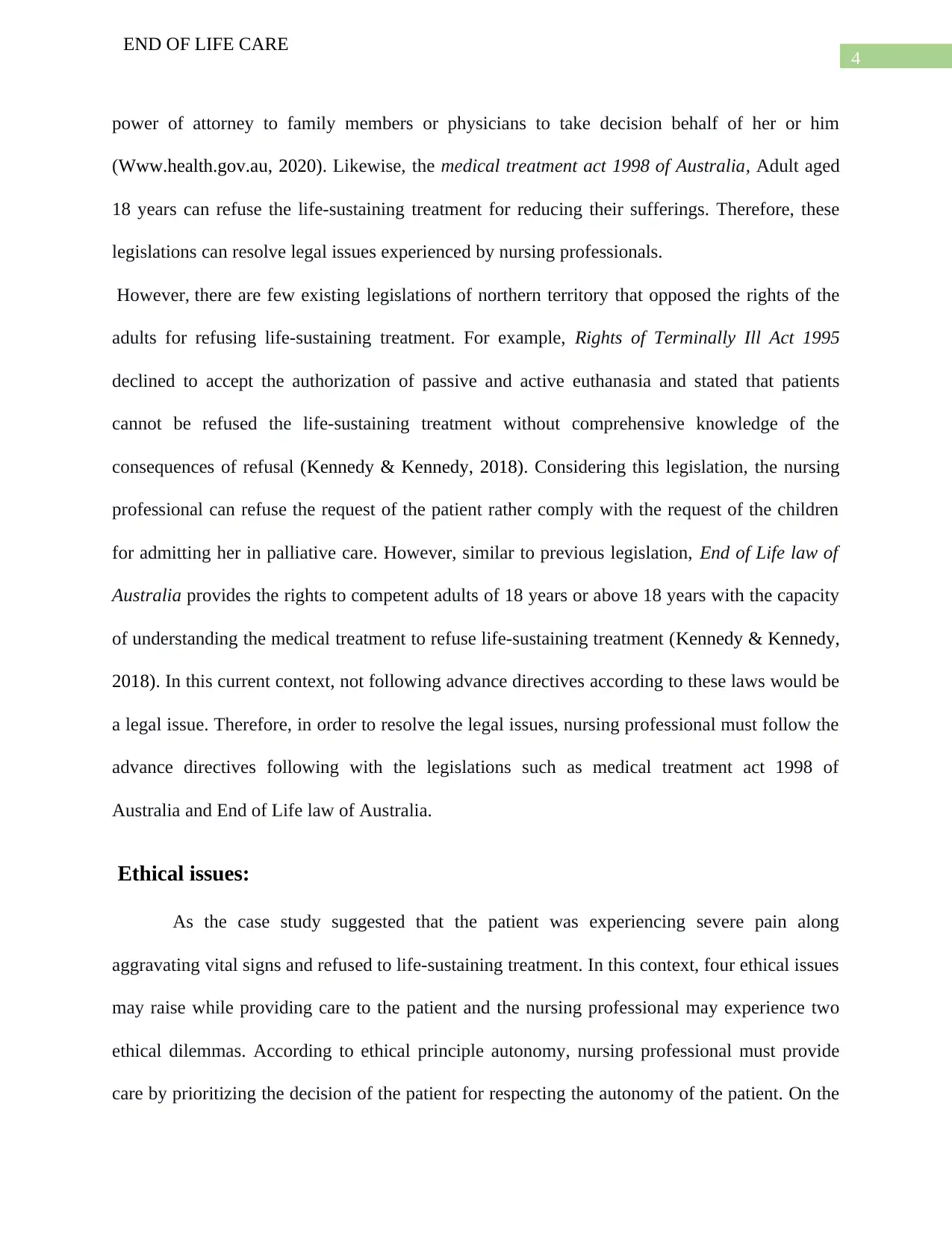
4
END OF LIFE CARE
power of attorney to family members or physicians to take decision behalf of her or him
(Www.health.gov.au, 2020). Likewise, the medical treatment act 1998 of Australia, Adult aged
18 years can refuse the life-sustaining treatment for reducing their sufferings. Therefore, these
legislations can resolve legal issues experienced by nursing professionals.
However, there are few existing legislations of northern territory that opposed the rights of the
adults for refusing life-sustaining treatment. For example, Rights of Terminally Ill Act 1995
declined to accept the authorization of passive and active euthanasia and stated that patients
cannot be refused the life-sustaining treatment without comprehensive knowledge of the
consequences of refusal (Kennedy & Kennedy, 2018). Considering this legislation, the nursing
professional can refuse the request of the patient rather comply with the request of the children
for admitting her in palliative care. However, similar to previous legislation, End of Life law of
Australia provides the rights to competent adults of 18 years or above 18 years with the capacity
of understanding the medical treatment to refuse life-sustaining treatment (Kennedy & Kennedy,
2018). In this current context, not following advance directives according to these laws would be
a legal issue. Therefore, in order to resolve the legal issues, nursing professional must follow the
advance directives following with the legislations such as medical treatment act 1998 of
Australia and End of Life law of Australia.
Ethical issues:
As the case study suggested that the patient was experiencing severe pain along
aggravating vital signs and refused to life-sustaining treatment. In this context, four ethical issues
may raise while providing care to the patient and the nursing professional may experience two
ethical dilemmas. According to ethical principle autonomy, nursing professional must provide
care by prioritizing the decision of the patient for respecting the autonomy of the patient. On the
END OF LIFE CARE
power of attorney to family members or physicians to take decision behalf of her or him
(Www.health.gov.au, 2020). Likewise, the medical treatment act 1998 of Australia, Adult aged
18 years can refuse the life-sustaining treatment for reducing their sufferings. Therefore, these
legislations can resolve legal issues experienced by nursing professionals.
However, there are few existing legislations of northern territory that opposed the rights of the
adults for refusing life-sustaining treatment. For example, Rights of Terminally Ill Act 1995
declined to accept the authorization of passive and active euthanasia and stated that patients
cannot be refused the life-sustaining treatment without comprehensive knowledge of the
consequences of refusal (Kennedy & Kennedy, 2018). Considering this legislation, the nursing
professional can refuse the request of the patient rather comply with the request of the children
for admitting her in palliative care. However, similar to previous legislation, End of Life law of
Australia provides the rights to competent adults of 18 years or above 18 years with the capacity
of understanding the medical treatment to refuse life-sustaining treatment (Kennedy & Kennedy,
2018). In this current context, not following advance directives according to these laws would be
a legal issue. Therefore, in order to resolve the legal issues, nursing professional must follow the
advance directives following with the legislations such as medical treatment act 1998 of
Australia and End of Life law of Australia.
Ethical issues:
As the case study suggested that the patient was experiencing severe pain along
aggravating vital signs and refused to life-sustaining treatment. In this context, four ethical issues
may raise while providing care to the patient and the nursing professional may experience two
ethical dilemmas. According to ethical principle autonomy, nursing professional must provide
care by prioritizing the decision of the patient for respecting the autonomy of the patient. On the
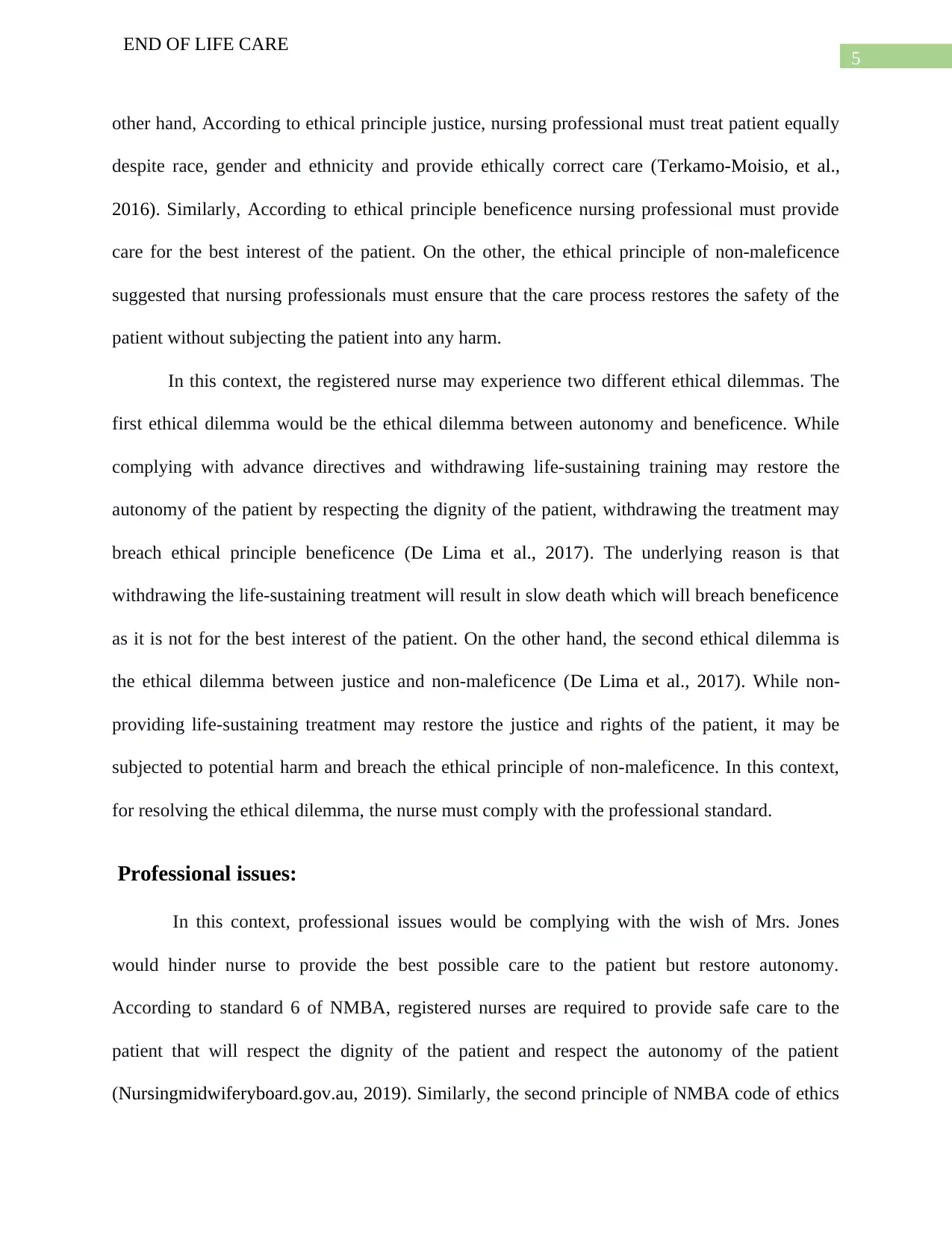
5
END OF LIFE CARE
other hand, According to ethical principle justice, nursing professional must treat patient equally
despite race, gender and ethnicity and provide ethically correct care (Terkamo-Moisio, et al.,
2016). Similarly, According to ethical principle beneficence nursing professional must provide
care for the best interest of the patient. On the other, the ethical principle of non-maleficence
suggested that nursing professionals must ensure that the care process restores the safety of the
patient without subjecting the patient into any harm.
In this context, the registered nurse may experience two different ethical dilemmas. The
first ethical dilemma would be the ethical dilemma between autonomy and beneficence. While
complying with advance directives and withdrawing life-sustaining training may restore the
autonomy of the patient by respecting the dignity of the patient, withdrawing the treatment may
breach ethical principle beneficence (De Lima et al., 2017). The underlying reason is that
withdrawing the life-sustaining treatment will result in slow death which will breach beneficence
as it is not for the best interest of the patient. On the other hand, the second ethical dilemma is
the ethical dilemma between justice and non-maleficence (De Lima et al., 2017). While non-
providing life-sustaining treatment may restore the justice and rights of the patient, it may be
subjected to potential harm and breach the ethical principle of non-maleficence. In this context,
for resolving the ethical dilemma, the nurse must comply with the professional standard.
Professional issues:
In this context, professional issues would be complying with the wish of Mrs. Jones
would hinder nurse to provide the best possible care to the patient but restore autonomy.
According to standard 6 of NMBA, registered nurses are required to provide safe care to the
patient that will respect the dignity of the patient and respect the autonomy of the patient
(Nursingmidwiferyboard.gov.au, 2019). Similarly, the second principle of NMBA code of ethics
END OF LIFE CARE
other hand, According to ethical principle justice, nursing professional must treat patient equally
despite race, gender and ethnicity and provide ethically correct care (Terkamo-Moisio, et al.,
2016). Similarly, According to ethical principle beneficence nursing professional must provide
care for the best interest of the patient. On the other, the ethical principle of non-maleficence
suggested that nursing professionals must ensure that the care process restores the safety of the
patient without subjecting the patient into any harm.
In this context, the registered nurse may experience two different ethical dilemmas. The
first ethical dilemma would be the ethical dilemma between autonomy and beneficence. While
complying with advance directives and withdrawing life-sustaining training may restore the
autonomy of the patient by respecting the dignity of the patient, withdrawing the treatment may
breach ethical principle beneficence (De Lima et al., 2017). The underlying reason is that
withdrawing the life-sustaining treatment will result in slow death which will breach beneficence
as it is not for the best interest of the patient. On the other hand, the second ethical dilemma is
the ethical dilemma between justice and non-maleficence (De Lima et al., 2017). While non-
providing life-sustaining treatment may restore the justice and rights of the patient, it may be
subjected to potential harm and breach the ethical principle of non-maleficence. In this context,
for resolving the ethical dilemma, the nurse must comply with the professional standard.
Professional issues:
In this context, professional issues would be complying with the wish of Mrs. Jones
would hinder nurse to provide the best possible care to the patient but restore autonomy.
According to standard 6 of NMBA, registered nurses are required to provide safe care to the
patient that will respect the dignity of the patient and respect the autonomy of the patient
(Nursingmidwiferyboard.gov.au, 2019). Similarly, the second principle of NMBA code of ethics
⊘ This is a preview!⊘
Do you want full access?
Subscribe today to unlock all pages.

Trusted by 1+ million students worldwide
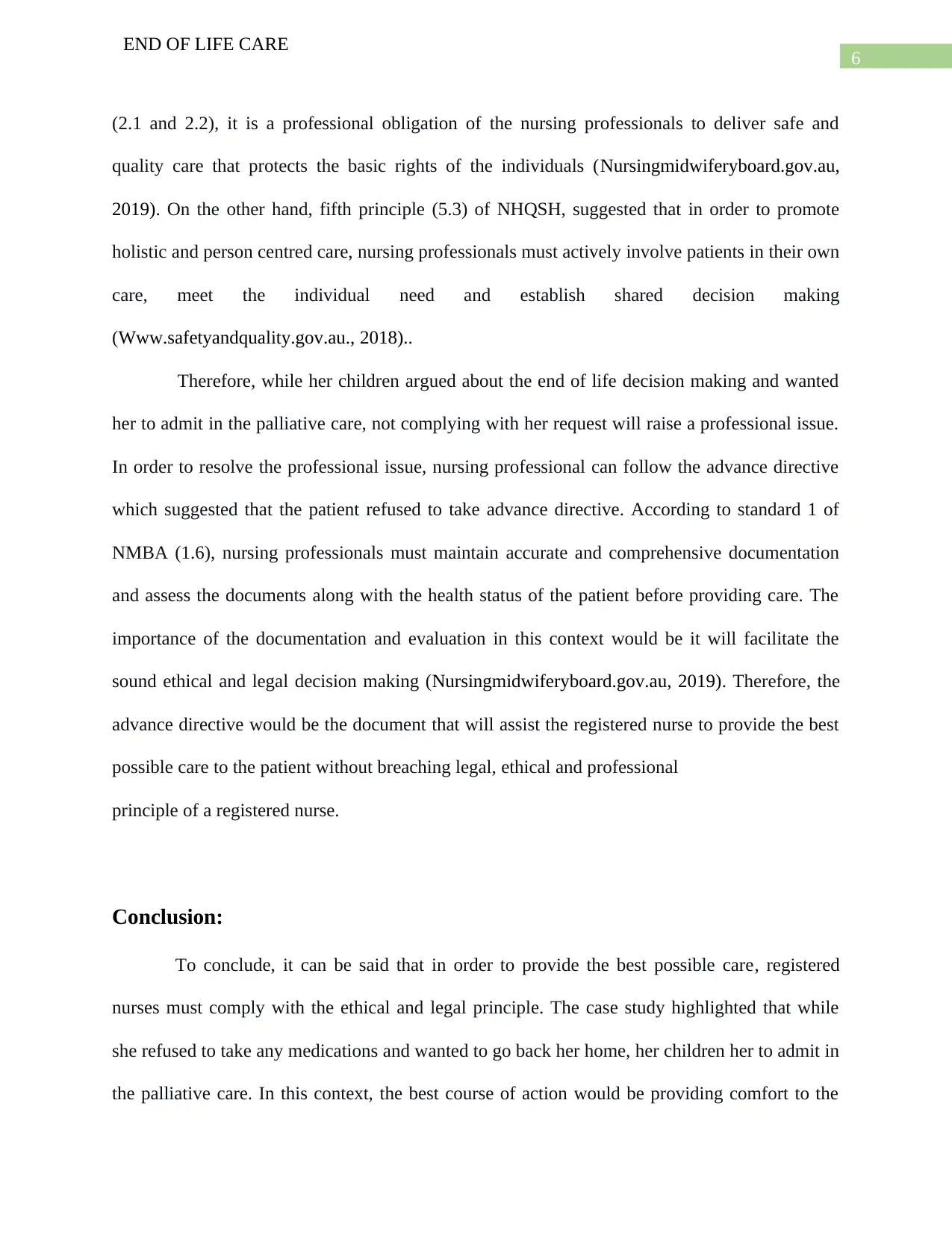
6
END OF LIFE CARE
(2.1 and 2.2), it is a professional obligation of the nursing professionals to deliver safe and
quality care that protects the basic rights of the individuals (Nursingmidwiferyboard.gov.au,
2019). On the other hand, fifth principle (5.3) of NHQSH, suggested that in order to promote
holistic and person centred care, nursing professionals must actively involve patients in their own
care, meet the individual need and establish shared decision making
(Www.safetyandquality.gov.au., 2018)..
Therefore, while her children argued about the end of life decision making and wanted
her to admit in the palliative care, not complying with her request will raise a professional issue.
In order to resolve the professional issue, nursing professional can follow the advance directive
which suggested that the patient refused to take advance directive. According to standard 1 of
NMBA (1.6), nursing professionals must maintain accurate and comprehensive documentation
and assess the documents along with the health status of the patient before providing care. The
importance of the documentation and evaluation in this context would be it will facilitate the
sound ethical and legal decision making (Nursingmidwiferyboard.gov.au, 2019). Therefore, the
advance directive would be the document that will assist the registered nurse to provide the best
possible care to the patient without breaching legal, ethical and professional
principle of a registered nurse.
Conclusion:
To conclude, it can be said that in order to provide the best possible care, registered
nurses must comply with the ethical and legal principle. The case study highlighted that while
she refused to take any medications and wanted to go back her home, her children her to admit in
the palliative care. In this context, the best course of action would be providing comfort to the
END OF LIFE CARE
(2.1 and 2.2), it is a professional obligation of the nursing professionals to deliver safe and
quality care that protects the basic rights of the individuals (Nursingmidwiferyboard.gov.au,
2019). On the other hand, fifth principle (5.3) of NHQSH, suggested that in order to promote
holistic and person centred care, nursing professionals must actively involve patients in their own
care, meet the individual need and establish shared decision making
(Www.safetyandquality.gov.au., 2018)..
Therefore, while her children argued about the end of life decision making and wanted
her to admit in the palliative care, not complying with her request will raise a professional issue.
In order to resolve the professional issue, nursing professional can follow the advance directive
which suggested that the patient refused to take advance directive. According to standard 1 of
NMBA (1.6), nursing professionals must maintain accurate and comprehensive documentation
and assess the documents along with the health status of the patient before providing care. The
importance of the documentation and evaluation in this context would be it will facilitate the
sound ethical and legal decision making (Nursingmidwiferyboard.gov.au, 2019). Therefore, the
advance directive would be the document that will assist the registered nurse to provide the best
possible care to the patient without breaching legal, ethical and professional
principle of a registered nurse.
Conclusion:
To conclude, it can be said that in order to provide the best possible care, registered
nurses must comply with the ethical and legal principle. The case study highlighted that while
she refused to take any medications and wanted to go back her home, her children her to admit in
the palliative care. In this context, the best course of action would be providing comfort to the
Paraphrase This Document
Need a fresh take? Get an instant paraphrase of this document with our AI Paraphraser
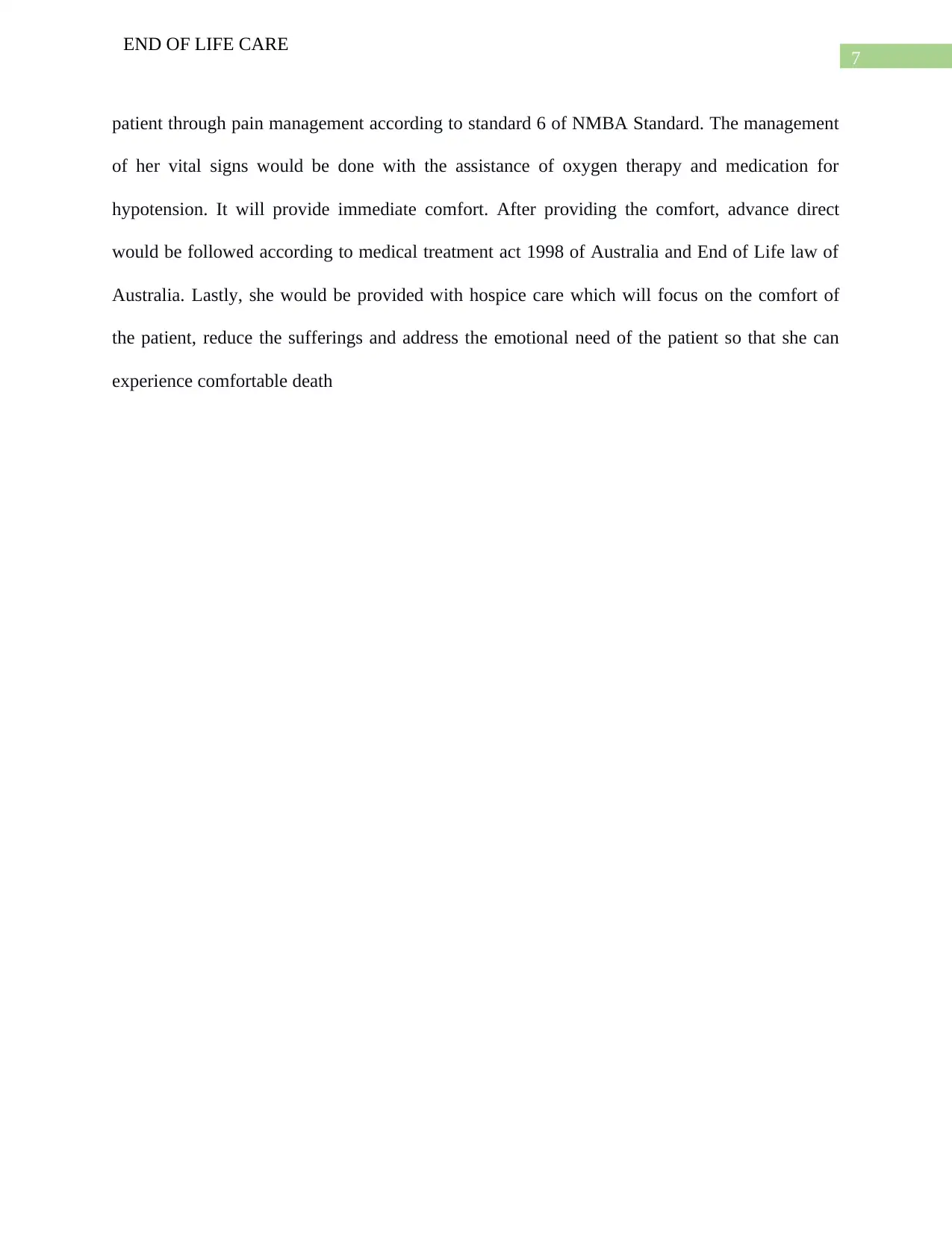
7
END OF LIFE CARE
patient through pain management according to standard 6 of NMBA Standard. The management
of her vital signs would be done with the assistance of oxygen therapy and medication for
hypotension. It will provide immediate comfort. After providing the comfort, advance direct
would be followed according to medical treatment act 1998 of Australia and End of Life law of
Australia. Lastly, she would be provided with hospice care which will focus on the comfort of
the patient, reduce the sufferings and address the emotional need of the patient so that she can
experience comfortable death
END OF LIFE CARE
patient through pain management according to standard 6 of NMBA Standard. The management
of her vital signs would be done with the assistance of oxygen therapy and medication for
hypotension. It will provide immediate comfort. After providing the comfort, advance direct
would be followed according to medical treatment act 1998 of Australia and End of Life law of
Australia. Lastly, she would be provided with hospice care which will focus on the comfort of
the patient, reduce the sufferings and address the emotional need of the patient so that she can
experience comfortable death
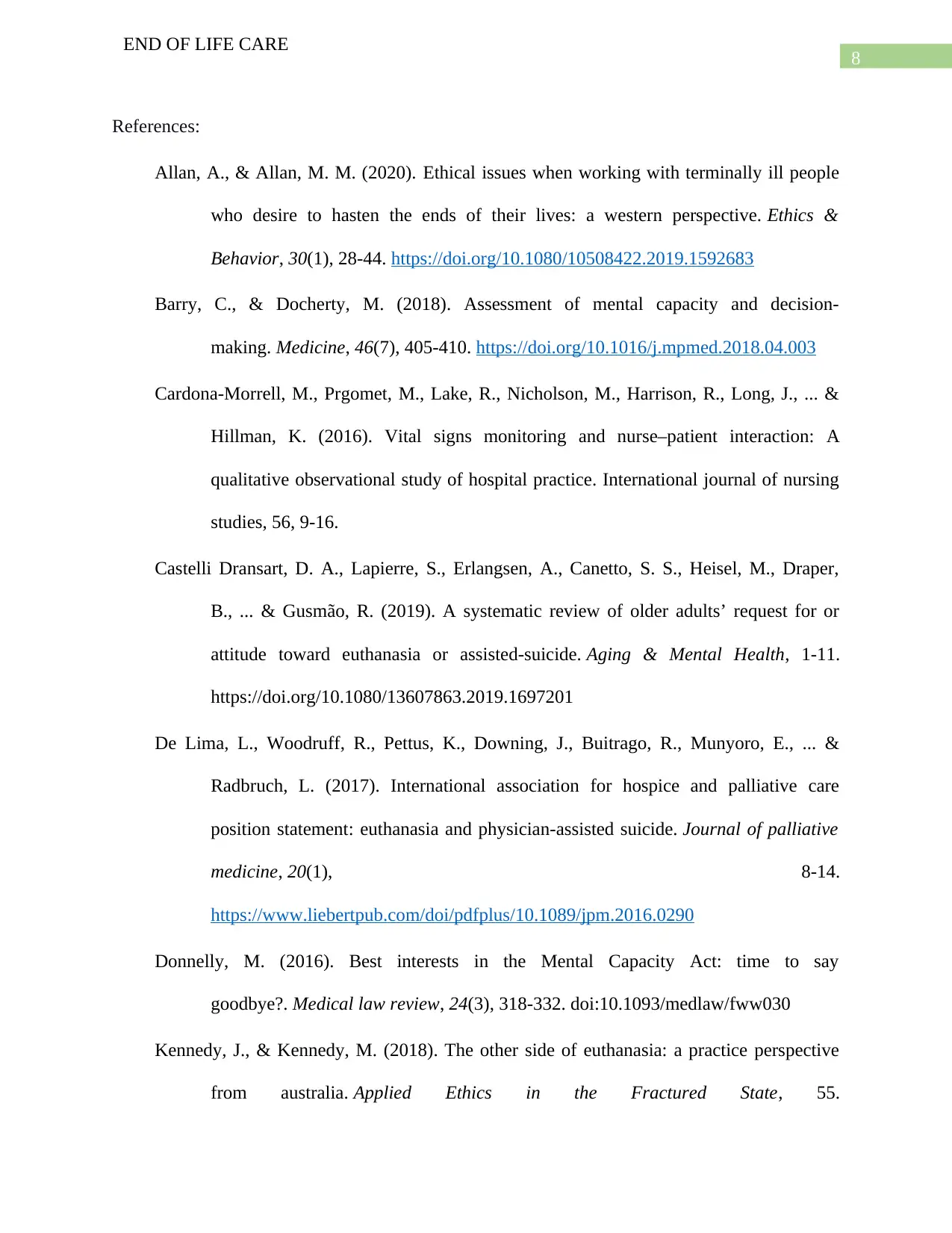
8
END OF LIFE CARE
References:
Allan, A., & Allan, M. M. (2020). Ethical issues when working with terminally ill people
who desire to hasten the ends of their lives: a western perspective. Ethics &
Behavior, 30(1), 28-44. https://doi.org/10.1080/10508422.2019.1592683
Barry, C., & Docherty, M. (2018). Assessment of mental capacity and decision-
making. Medicine, 46(7), 405-410. https://doi.org/10.1016/j.mpmed.2018.04.003
Cardona-Morrell, M., Prgomet, M., Lake, R., Nicholson, M., Harrison, R., Long, J., ... &
Hillman, K. (2016). Vital signs monitoring and nurse–patient interaction: A
qualitative observational study of hospital practice. International journal of nursing
studies, 56, 9-16.
Castelli Dransart, D. A., Lapierre, S., Erlangsen, A., Canetto, S. S., Heisel, M., Draper,
B., ... & Gusmão, R. (2019). A systematic review of older adults’ request for or
attitude toward euthanasia or assisted-suicide. Aging & Mental Health, 1-11.
https://doi.org/10.1080/13607863.2019.1697201
De Lima, L., Woodruff, R., Pettus, K., Downing, J., Buitrago, R., Munyoro, E., ... &
Radbruch, L. (2017). International association for hospice and palliative care
position statement: euthanasia and physician-assisted suicide. Journal of palliative
medicine, 20(1), 8-14.
https://www.liebertpub.com/doi/pdfplus/10.1089/jpm.2016.0290
Donnelly, M. (2016). Best interests in the Mental Capacity Act: time to say
goodbye?. Medical law review, 24(3), 318-332. doi:10.1093/medlaw/fww030
Kennedy, J., & Kennedy, M. (2018). The other side of euthanasia: a practice perspective
from australia. Applied Ethics in the Fractured State, 55.
END OF LIFE CARE
References:
Allan, A., & Allan, M. M. (2020). Ethical issues when working with terminally ill people
who desire to hasten the ends of their lives: a western perspective. Ethics &
Behavior, 30(1), 28-44. https://doi.org/10.1080/10508422.2019.1592683
Barry, C., & Docherty, M. (2018). Assessment of mental capacity and decision-
making. Medicine, 46(7), 405-410. https://doi.org/10.1016/j.mpmed.2018.04.003
Cardona-Morrell, M., Prgomet, M., Lake, R., Nicholson, M., Harrison, R., Long, J., ... &
Hillman, K. (2016). Vital signs monitoring and nurse–patient interaction: A
qualitative observational study of hospital practice. International journal of nursing
studies, 56, 9-16.
Castelli Dransart, D. A., Lapierre, S., Erlangsen, A., Canetto, S. S., Heisel, M., Draper,
B., ... & Gusmão, R. (2019). A systematic review of older adults’ request for or
attitude toward euthanasia or assisted-suicide. Aging & Mental Health, 1-11.
https://doi.org/10.1080/13607863.2019.1697201
De Lima, L., Woodruff, R., Pettus, K., Downing, J., Buitrago, R., Munyoro, E., ... &
Radbruch, L. (2017). International association for hospice and palliative care
position statement: euthanasia and physician-assisted suicide. Journal of palliative
medicine, 20(1), 8-14.
https://www.liebertpub.com/doi/pdfplus/10.1089/jpm.2016.0290
Donnelly, M. (2016). Best interests in the Mental Capacity Act: time to say
goodbye?. Medical law review, 24(3), 318-332. doi:10.1093/medlaw/fww030
Kennedy, J., & Kennedy, M. (2018). The other side of euthanasia: a practice perspective
from australia. Applied Ethics in the Fractured State, 55.
⊘ This is a preview!⊘
Do you want full access?
Subscribe today to unlock all pages.

Trusted by 1+ million students worldwide
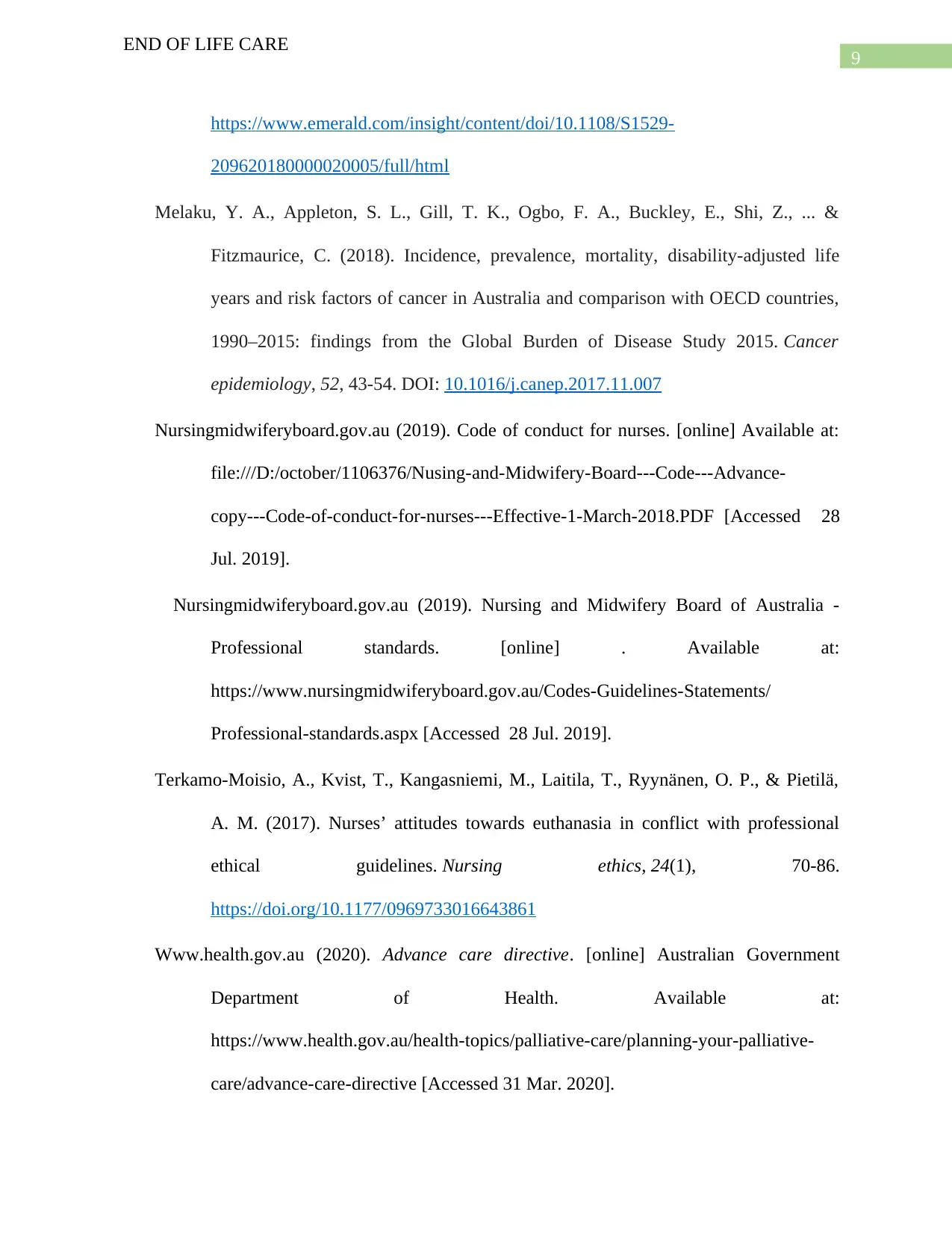
9
END OF LIFE CARE
https://www.emerald.com/insight/content/doi/10.1108/S1529-
209620180000020005/full/html
Melaku, Y. A., Appleton, S. L., Gill, T. K., Ogbo, F. A., Buckley, E., Shi, Z., ... &
Fitzmaurice, C. (2018). Incidence, prevalence, mortality, disability-adjusted life
years and risk factors of cancer in Australia and comparison with OECD countries,
1990–2015: findings from the Global Burden of Disease Study 2015. Cancer
epidemiology, 52, 43-54. DOI: 10.1016/j.canep.2017.11.007
Nursingmidwiferyboard.gov.au (2019). Code of conduct for nurses. [online] Available at:
file:///D:/october/1106376/Nusing-and-Midwifery-Board---Code---Advance-
copy---Code-of-conduct-for-nurses---Effective-1-March-2018.PDF [Accessed 28
Jul. 2019].
Nursingmidwiferyboard.gov.au (2019). Nursing and Midwifery Board of Australia -
Professional standards. [online] . Available at:
https://www.nursingmidwiferyboard.gov.au/Codes-Guidelines-Statements/
Professional-standards.aspx [Accessed 28 Jul. 2019].
Terkamo-Moisio, A., Kvist, T., Kangasniemi, M., Laitila, T., Ryynänen, O. P., & Pietilä,
A. M. (2017). Nurses’ attitudes towards euthanasia in conflict with professional
ethical guidelines. Nursing ethics, 24(1), 70-86.
https://doi.org/10.1177/0969733016643861
Www.health.gov.au (2020). Advance care directive. [online] Australian Government
Department of Health. Available at:
https://www.health.gov.au/health-topics/palliative-care/planning-your-palliative-
care/advance-care-directive [Accessed 31 Mar. 2020].
END OF LIFE CARE
https://www.emerald.com/insight/content/doi/10.1108/S1529-
209620180000020005/full/html
Melaku, Y. A., Appleton, S. L., Gill, T. K., Ogbo, F. A., Buckley, E., Shi, Z., ... &
Fitzmaurice, C. (2018). Incidence, prevalence, mortality, disability-adjusted life
years and risk factors of cancer in Australia and comparison with OECD countries,
1990–2015: findings from the Global Burden of Disease Study 2015. Cancer
epidemiology, 52, 43-54. DOI: 10.1016/j.canep.2017.11.007
Nursingmidwiferyboard.gov.au (2019). Code of conduct for nurses. [online] Available at:
file:///D:/october/1106376/Nusing-and-Midwifery-Board---Code---Advance-
copy---Code-of-conduct-for-nurses---Effective-1-March-2018.PDF [Accessed 28
Jul. 2019].
Nursingmidwiferyboard.gov.au (2019). Nursing and Midwifery Board of Australia -
Professional standards. [online] . Available at:
https://www.nursingmidwiferyboard.gov.au/Codes-Guidelines-Statements/
Professional-standards.aspx [Accessed 28 Jul. 2019].
Terkamo-Moisio, A., Kvist, T., Kangasniemi, M., Laitila, T., Ryynänen, O. P., & Pietilä,
A. M. (2017). Nurses’ attitudes towards euthanasia in conflict with professional
ethical guidelines. Nursing ethics, 24(1), 70-86.
https://doi.org/10.1177/0969733016643861
Www.health.gov.au (2020). Advance care directive. [online] Australian Government
Department of Health. Available at:
https://www.health.gov.au/health-topics/palliative-care/planning-your-palliative-
care/advance-care-directive [Accessed 31 Mar. 2020].
Paraphrase This Document
Need a fresh take? Get an instant paraphrase of this document with our AI Paraphraser
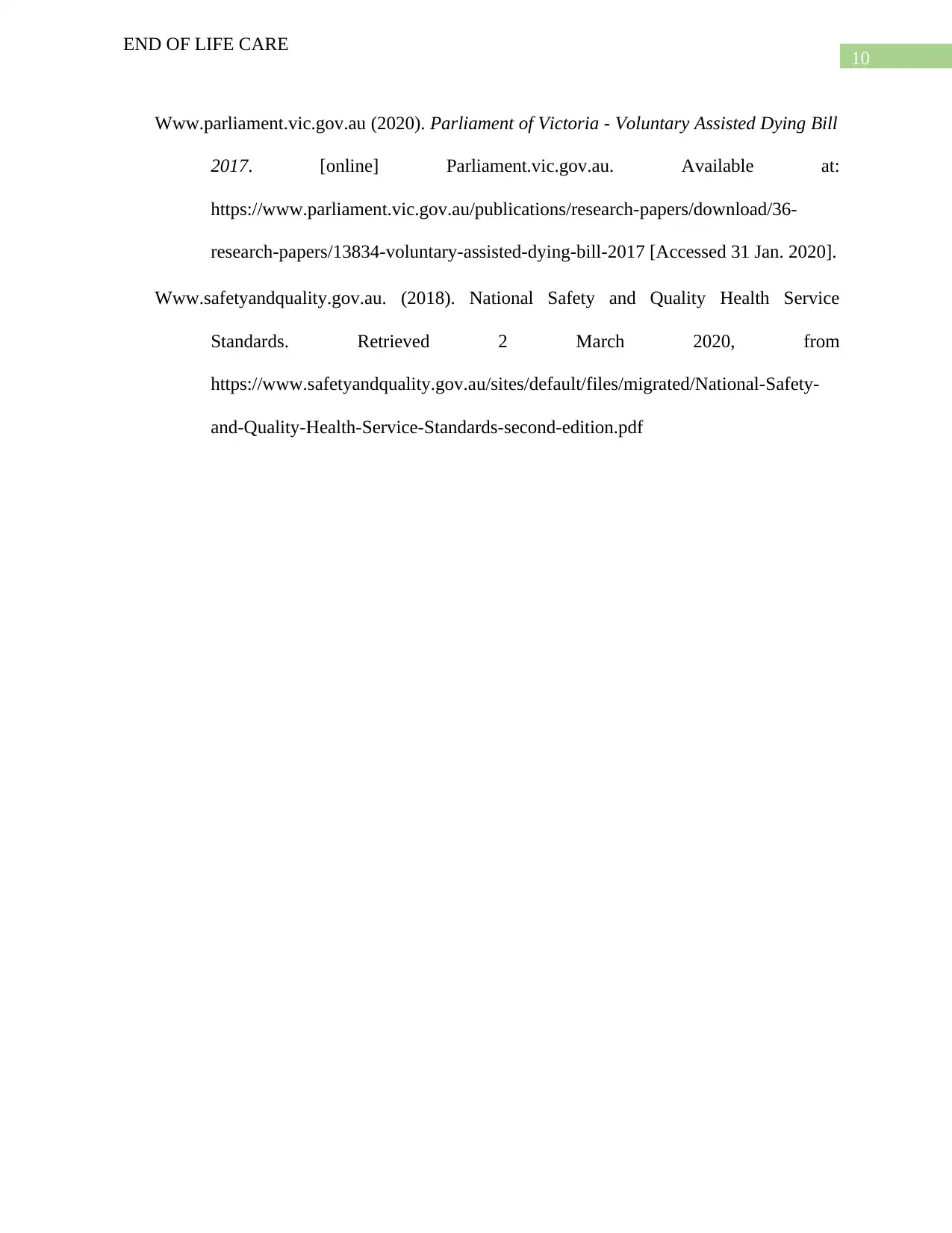
10
END OF LIFE CARE
Www.parliament.vic.gov.au (2020). Parliament of Victoria - Voluntary Assisted Dying Bill
2017. [online] Parliament.vic.gov.au. Available at:
https://www.parliament.vic.gov.au/publications/research-papers/download/36-
research-papers/13834-voluntary-assisted-dying-bill-2017 [Accessed 31 Jan. 2020].
Www.safetyandquality.gov.au. (2018). National Safety and Quality Health Service
Standards. Retrieved 2 March 2020, from
https://www.safetyandquality.gov.au/sites/default/files/migrated/National-Safety-
and-Quality-Health-Service-Standards-second-edition.pdf
END OF LIFE CARE
Www.parliament.vic.gov.au (2020). Parliament of Victoria - Voluntary Assisted Dying Bill
2017. [online] Parliament.vic.gov.au. Available at:
https://www.parliament.vic.gov.au/publications/research-papers/download/36-
research-papers/13834-voluntary-assisted-dying-bill-2017 [Accessed 31 Jan. 2020].
Www.safetyandquality.gov.au. (2018). National Safety and Quality Health Service
Standards. Retrieved 2 March 2020, from
https://www.safetyandquality.gov.au/sites/default/files/migrated/National-Safety-
and-Quality-Health-Service-Standards-second-edition.pdf
1 out of 11
Related Documents
Your All-in-One AI-Powered Toolkit for Academic Success.
+13062052269
info@desklib.com
Available 24*7 on WhatsApp / Email
![[object Object]](/_next/static/media/star-bottom.7253800d.svg)
Unlock your academic potential
Copyright © 2020–2025 A2Z Services. All Rights Reserved. Developed and managed by ZUCOL.





